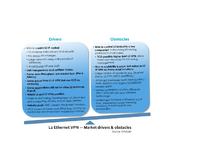Stuttgart, Germany ? The main reason, by far, for corporate users to choose an L2 Ethernet VPN is the wish to control L3 IP routing and thus to separate clearly the own IP routing from the one of the provider. Most service providers and vendors view this as the main driver for L2 Ethernet VPN. This is what results by a recent study carried out by InfoCom in order to investi-gate the market potential of Layer 2 Ethernet VPN.
The study, based on a very large number of interviews with customers, providers and vendors, revealed that there are several reasons why a company might want to manage IP routing on its own, the main one being simply a desire for data privacy and security. A side wish may be to reduce delays, for instance by avoiding to ask (and sometimes to discuss and justify) each routing changes with the provider. Finally, another simple reason why some enterprises may choose to manage L3 routing directly is that they already have adequate internal resources and basically do not wish to externalise. However, the vast majority of companies opt not to manage IP routing on their own.
Another popular argument in favour of L2 Ethernet VPN is that it enables LAN transparency and multiple VLANs. Customers can thus manage various geographical sites as a single LAN while also creating and managing different VLANs, for instance for different traffic types, applications, sites, single divisions or departments. Finally, an L2 Ethernet VPN enable to use IPv6, where the network operator itself does not yet support it.
The lack of availability of Ethernet local loops can represent a significant market obstacle for Layer 2 Ethernet VPN, especially outside large conurbations where fibre optic to support higher bandwidth is absent. To overcome this problem providers deploy EFM (Ethernet in the First Mile) over copper, which uses G.SHDSL.bis technology to reach typically up to 20 or 40 Mbit/s, as a very cost effective way to provide low Ethernet bandwidths to smaller sites.
Last but not least, companies and industry associations are pushing Ethernet services, as well as all vendors, this being probably the most efficient market driver of all. Overall InfoCom sees rather demand for L2 Ethernet VPN from companies from the media, financial and public sectors, and in particular from large financial institutions. A few large multinational companies may be interested in L2 Ethernet VPN, although it very much depends on the outsourcing strategy of the company. The market demand is also pushed by the wholesale sector, as wholesale customers choose to manage L3 routing themselves anyway. Lastly, the strong growth in mobile backhaul (related to increasing mobile data usage) and the move away from traditional Leased Lines, contributes to drive the demand for L2 Ethernet services.
About this extract: This extract in based on an article published on TS&T ? Telecom Strategies & Trends, InfoCom?s highly analytical telecoms publication. This ejournal provides in-depth articles on a wide vari-ety of compelling innovative topics. Each issue contains up-to date rigorous analysis. TS&T is available as an annual on-line subscription providing 24 issues throughout the whole year. If you are interested in this publication, do not hesitate to get in contact with us. Talk to us. We listen.
InfoCom is a market research and consultancy company with over 20 years experience providing strategic analyses and planning assistance to stakeholders in the telecommunications, IT and multimedia industries. InfoCom-s independent and fact-based analyses highlight trends and opportunities, supporting decision makers to understand market dynamics in order to improve their competitive advantage.


You must be logged in to post a comment Login